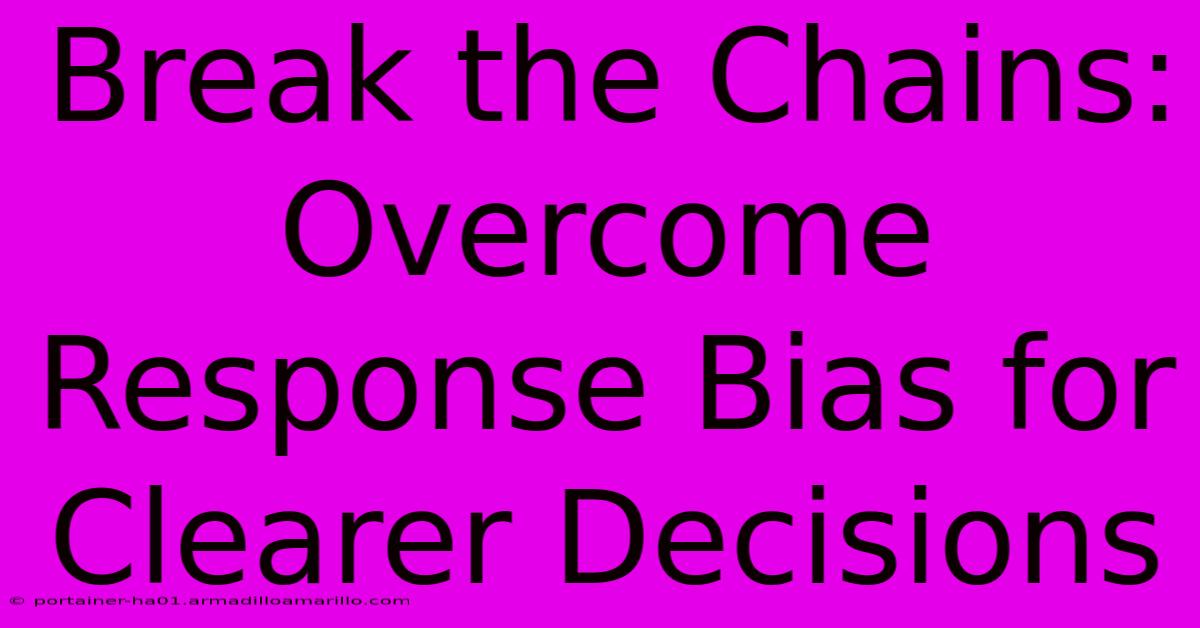Break The Chains: Overcome Response Bias For Clearer Decisions

Table of Contents
Break the Chains: Overcome Response Bias for Clearer Decisions
Response bias. It's a silent saboteur, subtly twisting our perceptions and leading us to make flawed decisions. Understanding and overcoming these biases is crucial for clear, objective thinking in all aspects of life, from personal choices to high-stakes business strategies. This article will explore common response biases and provide practical strategies to break free from their influence.
Understanding the Enemy: Types of Response Bias
Response bias, in simple terms, is the tendency for respondents to answer inaccurately or misleadingly. This isn't intentional deception; it's a subconscious phenomenon affecting how we process and respond to information. Here are some key types:
1. Acquiescence Bias (Yea-Saying):
This is the tendency to agree with statements regardless of their content. Think of surveys where people consistently select "agree" or "strongly agree" even when the questions are contradictory. This bias stems from a desire to please or avoid conflict.
2. Social Desirability Bias:
This bias manifests as a tendency to answer questions in a way that portrays oneself in a positive light, even if it's not entirely truthful. People want to appear likeable, competent, or morally upright, leading them to distort their responses.
3. Extremity Bias:
Some individuals consistently choose extreme options on rating scales or questionnaires, avoiding the middle ground. This can skew data and lead to inaccurate conclusions. This bias might be linked to personality traits or a desire to be decisive.
4. Confirmation Bias:
This isn't strictly a response bias, but it heavily influences how we interpret information and, subsequently, how we respond. Confirmation bias is the tendency to favor information that confirms pre-existing beliefs and dismiss contradictory evidence. It creates a filter that distorts objectivity.
Breaking the Chains: Strategies for Mitigation
Now that we've identified the enemy, let's explore practical strategies to combat these biases and make more informed decisions:
1. Anonymous Responses:
Whenever possible, ensure responses are anonymous. This reduces the pressure to present a socially desirable image, mitigating social desirability bias. Online surveys and feedback mechanisms should prioritize anonymity.
2. Balanced Question Wording:
Avoid leading questions or phrasing that encourages a particular answer. Use neutral language and present options equally. For example, instead of asking, "Do you agree that our product is excellent?", try, "How would you rate our product on a scale of 1 to 5?" Carefully crafted questions are paramount.
3. Mix Up Question Order:
Randomizing the order of questions can help reduce order effects, where the answers to earlier questions influence subsequent responses. This is particularly crucial in lengthy surveys.
4. Include a "Don't Know" or "Neutral" Option:
Providing a neutral option reduces pressure to choose an extreme or biased response. This allows respondents to honestly admit uncertainty, leading to more accurate data. This simple addition dramatically improves data integrity.
5. Utilize Multiple Methods:
Triangulation is key. Use multiple data collection methods (interviews, surveys, observations) to cross-reference information and identify potential response biases. Combining different approaches helps compensate for individual biases.
6. Employ Blind Review Processes:
If possible, blind review processes eliminate the influence of preconceived notions. This is particularly relevant in research or evaluation settings, allowing for unbiased assessment. This is critical for objective analysis.
7. Self-Reflection and Awareness:
The most crucial step involves self-awareness. Recognize your own potential biases and actively challenge your assumptions. Continuous self-reflection is the foundation of critical thinking.
Conclusion: Towards Clearer Thinking
Overcoming response biases requires consistent effort and a commitment to objective thinking. By implementing these strategies, we can break free from the chains of subconscious influences and make clearer, more informed decisions in every facet of our lives. This leads to better personal choices, more effective strategies, and a deeper understanding of ourselves and the world around us. The journey to clearer thinking starts with recognizing the biases that cloud our judgment – and then taking proactive steps to mitigate their impact.

Thank you for visiting our website wich cover about Break The Chains: Overcome Response Bias For Clearer Decisions. We hope the information provided has been useful to you. Feel free to contact us if you have any questions or need further assistance. See you next time and dont miss to bookmark.
Featured Posts
-
The Future Of Communication Mail Hosting Trends To Watch In 2024
Feb 07, 2025
-
Prepare To Be Enchanted Discover The Secret To Disney Magic Unveiled
Feb 07, 2025
-
Your Digital Sanctuary Escape Into A Realm Of Endless Possibilities
Feb 07, 2025
-
Churchills Pact With The Underworld A Devilish Alliance For Victory
Feb 07, 2025
-
Tis The Season To Sparkle Add A Touch Of Magic To Your Signatures With Holiday Icons
Feb 07, 2025
